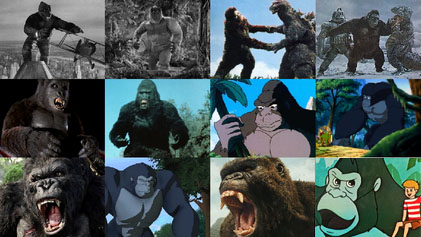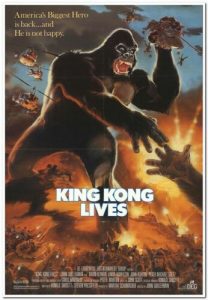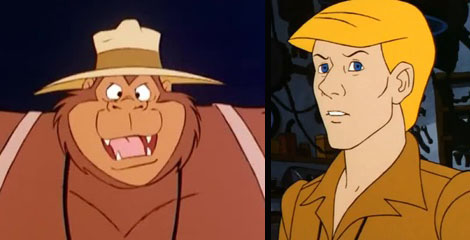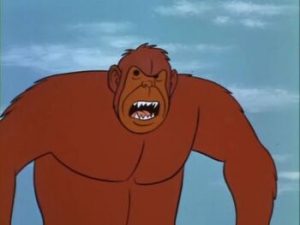SUSPENDED ANIMATION #257

Multiple attempts have been made to translate the iconic King Kong character into animation.
In 1976, Fred Calvert, president of Farmhouse Films, announced that he was preparing a six part animated adaptation of the famous story for Saturday morning. Calvert based his effort on the then recent ruling that the original novel was in public domain due to improper copyright renewal.
 DePatie-Freleng Enterterprises that very same month stated they had joined forces with producers Walter Bien and Gene Farmer to develop an animated series based on the character. Neither project was completed.
DePatie-Freleng Enterterprises that very same month stated they had joined forces with producers Walter Bien and Gene Farmer to develop an animated series based on the character. Neither project was completed.
King Kong Lives (1986) was a live-action sequel to the Dino De Laurentiis film King Kong (1976). The film was a notorious failure.
In the sequel, after being shot down from the World Trade Center, it is discovered Kong is still barely alive and so is kept in a coma for ten years. In order to save the giant ape’s life, a heart transplant is done using blood from a giant female ape that is found in Borneo.
After the operation, Kong and the female escape but it turns out she is pregnant. Kong’s artificial heart gives out after killing the bad military guy and “Lady” Kong gives birth to an infant son and they return to the jungles of Borneo.
Before the film was even released in late December, De Laurentiis was considering possible sequels including a live action film that would have centered on a teenaged son of Kong in France where he would climb the Eiffel Tower during the climax.
In July 1987, a producer from De Laurentiis Productions noticing the success of Filmation’s Ghostbusters animated series approached the company with the idea of doing a series featuring Kong’s young son from the movie.

The most famous animated version of Kong remains the Rankin-Bass 1966 Saturday morning series.
Robert Lamb moved from Arizona to Los Angeles in 1976 hoping to find work in the animation industry but his drawing skill was not strong enough. In 1981, at the urging of Filmation storyboard and development artist Robert Kline, Lamb interviewed for a job as a storyboard artist. His first job was on The New Adventures of Zorro and he later worked on Blackstar, He-Man and the Masters of the Universe, and BraveStarr among other shows until he left in 1989.
Lamb said, “Working as a writer and storyboard artist at Filmation was one of the best times in my career. I’ve done other interesting and rewarding projects since then, but 1981 to 1989 were the Golden Years for me.”
In 1987, Lamb had expressed an interest in moving into development so was assigned to go to De Laurentiis’ Beverly Hills office to meet with one of the producers about developing a show with a teenaged Kong.
The De Laurentiis team had dubbed the character “Kid Kong” and already had some ideas of how they wanted the character presented. They pitched that Kid Kong could grow as large as a mountain (in the live action film Kong was roughly 55 feet high at his tallest), shoot laser beams out of his eyes, turn invisible, blow buildings down with his breath and be able to fly through outer space so he could travel to different planets.
Lamb wisely pointed out that limiting Kid Kong’s powers would make him more interesting and vulnerable which would generate better stories. Basically, it would offer the opportunity for more jeopardy and drama.
They finally agreed that the character would only be able to shift his size so he could be as tall as his father or as small as a mouse but would generally be about six feet tall to better interact with the human characters in the story. At some point, a weakness would be developed that would prevent Kid Kong from exercising this power at times.
Lamb also suggested that instead of visiting other planets to just have the character travel to exotic areas around the world “like Jonny Quest” which it turned out was a series that the De Laurentiis producer loved. In addition, this would open up the possibility of some environmental education storylines.
Lamb was paid for two week’s worth of production sketches. He created over forty black-and-white sketches and a preliminary series bible. He drew characters, vehicles, weapons and scenes.

The Kong-like “Shadow Beasts” were created by Paul Dini for Filmation’s “He-Man And The Masters Of The Universe”
Kid Kong had designed and built the Coco-Nautilus, a submarine that could travel underwater, on the surface of the ocean and fly through the air even into outer space. The hull of the ship was made from giant coconuts and bamboo from Kong Island.
Lamb even created an intricate schematic of the vehicle detailing diving chamber, lab, storage, ballast tank, engine room and more. The Coco-Nautilus would plow through the massive exterior waterfall on Kong Island to access a water filled tunnel behind the falls. The submarine would then emerge inside a huge cavern and dock near an ancient temple built centuries ago to honor the Kong dynasty.
Lamb told author John Lemay, “I created a billionaire industrialist/big game hunter named Rex Thorne. One of his subsidiary companies, Petrox Petroleum Corp. had found Kid’s father, King Kong, while exploring for new sources of oil. Thorne has a team of villainous minions like Professor Wilhelm Petroff, who is responsible for Thorne’s diverse arsenal of weapons, vehicles and devices.

Filmation’s most famous version of “Kong” was played by Forrest Tucker (center) on their live action GHOST BUSTERS (1975) series. “Spencer” was veteran cartoon voice actor Larry Storch. “Tracy” the gorilla was played by Bob Burns.
The thin-mustached, slightly graying hair at his temples Thorne would think that anything relating to King Kong is rightfully his since it was one of his companies that found the giant ape. He would live in Thornehaven, a medieval fortress that towers above the black rock walls on a fog-enshrouded island stronghold not too far from Kong Island.
He has built a menagerie of the rarest animals caged in pens on his estate with a special cage prepared for Kid Kong. Thorne has become bored with ordinary game hunting as the walls of Thornehaven Hall are crammed with his trophies.
Mechida is efficient, hard-working and totally dedicated to Thorne. She virtually runs Thorne Industries because Thorne is usually away hunting Kid Kong. She is an actual ninja warrior with the appropriate attire.
Professor Wilhelm Petroff is a brilliant, bald, goateed scientist with a private laboratory at Thornhaven. He has no sense of humor and is totally focused on his work creating devices like Thorne’s Attila, an all terrain land rover with massive tusks on the front, and W.A.R.T. (Wilhelm Armored Robotic Technician) that can sprout numerous appendages from its cylindrical torso.
Lou Scheimer liked the ideas and a meeting was arranged with him and the De Laurentiis producer who also liked the ideas. The reason the series never went any further was that Scheimer was approaching it as a co-production arrangement and De Laurentiis was looking for a work-for-hire deal.

Filmation finally animated “Kong” in their 1986 GHOSTBUSTERS animated series (aka “The Original Ghostbusters”). Tracey the gorilla (left) was voiced by producer Lou Scheimer himself; Pat Fraley voiced “Jake Kong, Jr.” (right).



 Jim Korkis is an internationally respected animation historian who in recent years has devoted his attention to the many worlds of Disney. He was a columnist for a variety of animation magazines. With his former writing partner, John Cawley, he authored several animation related books including The Encyclopedia of Cartoon Superstars, How to Create Animation, Cartoon Confidential and Get Animated’s Animation Art Buyer’s Guide. He taught animation classes at the Disney Institute in Florida as well as instructing classes on acting and animation history for Disney Feature Animation: Florida.
Jim Korkis is an internationally respected animation historian who in recent years has devoted his attention to the many worlds of Disney. He was a columnist for a variety of animation magazines. With his former writing partner, John Cawley, he authored several animation related books including The Encyclopedia of Cartoon Superstars, How to Create Animation, Cartoon Confidential and Get Animated’s Animation Art Buyer’s Guide. He taught animation classes at the Disney Institute in Florida as well as instructing classes on acting and animation history for Disney Feature Animation: Florida.




















































Thank you for one good laugh today! The funniest part is that Robert Lamb’s concept for a Kid Kong series actually sounds pretty good. It probably would have been too ambitious for Filmation, though — unless Kid Kong’s human friends formed a bubblegum-pop band so they could reuse animation from The Archies.
Mechida the ninja warrior executive secretary sounds like a fascinating character, and I would love to see some of the concept art for her; however, her name doesn’t make any sense in Japanese. “Mochida” is an actual Japanese surname, as in Mochida Pharmaceutical. “Machida” is a city in western Tokyo Prefecture, the home town of Pokemon creator Satoshi Tajiri. “Moichido” means “one more time”, which might make a cute nickname for someone who never gets anything right at first. But “Mechida”? Eye blood rice paddy? I don’t get it.
Kid Kong built a submarine/boat/spaceship out of bamboo and coconuts? Not even the Professor on Gilligan’s Island could do that!
Funny, as “Kid Kong” was already a character, first from a comic series called “Monster Fun” (drawn by Robert Nixon) http://kazoop.blogspot.com/2014/03/a-look-at-monster-fun-strips-kid-kong.html, and then, a toy in the early 80’s (I remembered a bit of a “Kong” craze then, as you had Donkey Kong, and then Kid Kong; I remembered the toy, not the comic). http://bztoybox.blogspot.com/2012/10/tomy-plastic-games-things-by-milton.html Don’t know if they were related.
So if this had been done, I’ll bet it would have been another legal claim, like Quackula.